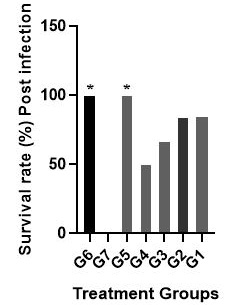In-Vitro and In-Vivo Antimicrobial Activity of Five Medicinal Plants against Virulent Escherichia coli O157:H7 Strain Harboring Shiga Toxin Gene
Asfand Yar Khan1, Syed Saleem Ahmad1*, Muhammad Avais1 and Kamran Ashraf2
1Department of Veterinary Medicine, University of Veterinary and Animal Sciences, Lahore 54000, Pakistan
2Department of Parasitology, University of Veterinary and Animal Sciences, Lahore 54000, Pakistan
Fig. 1.
Zones of inhibition induce by cold aqueous extracts of five medicinal plants against E. coli O157:H7 (All the values are expressed in mean ± standard error.
Fig. 2.
The survival percentage of treated groups post infection. Marked * showed a significant higher survival rate in G6 and G5 (100 %, P<0.01) than control and G1-4 treatment groups.
Fig. 4.
Histo-pathological changes in liver (A, B), broiler heart (C), intestines (D, E,F) and spleen (G).
The encircled area in A (positive control) shows necrosis with empty spaces along with karyorrhexis and diffused congestion in the liver. The encircle area in B shows the diffused congestion in the liver. C Shows extensive presence of inflammatory cells in the myocarditis. D shows disrupted villi (arrows) while the stars in E indicated elongation of the glands of the cecum and lymphocytic proliferation (arrows) in cecum of W. coagulans group Photomicrographs of broiler intestine and spleen group 4. F showes abnormal elongation of the villi of intestine of Nigella sativa treated group encircled area in G showed the infiltration of inflammatory cells, lymphocytes and neutrophils in spleen.












